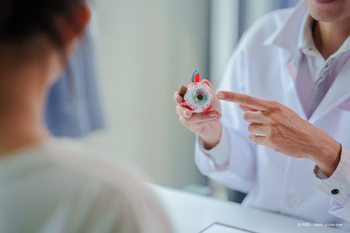
New research raises questions about the current clinical approach to inherited retinal diseases
Alfredo Sadun, MD, PhD, details a fascinating outcome from a gene therapy in development for Leber hereditary optic neuropathy.
During the recent Association for Research in Vision and Ophthalmology (ARVO) meeting, Alfredo Sadun, MD, PhD, chief of Ophthalmology at the Doheny Eye Institute, University of California Los Angeles, shared some exciting new research with the Eye Care Network.
In Salt Lake City, Utah, Prof. Sadun detailed a recent project examining Leber hereditary optic neuropathy (LHON). The research produced an unexpected result, but the research findings could open new possibilities for adeno-associated virus (AAV) delivery of gene therapies, especially for inherited retinal diseases.
Editor's note: The below Q&A has been lightly edited for clarity.
Eye Care Network: Tell us about the research findings you brought to ARVO.
Alfredo Sadun, MD, PhD: I'm a neuro-ophthalmologist with a great interest in one particular disease, which is Leber hereditary optic neuropathy. This is a genetic disease where you do just fine until you turn 20 or so, and then you suddenly go blind, first in one and then the other eye, very dramatically and very unfortunately. So we've been doing research together with GeneSight from Paris, France, for gene therapy for this disease. In doing so, we have found out that, at least in some patients, an injection of the gene via AAV2 intravitreally can lead to some improvement.
This trial both succeeded and failed, enormously, because of the same phenomena. An injection in one eye somehow mysteriously caused improvement of vision in both eyes. This was a failure in the sense that, the FDA said, "You get approval if you can show the injected eye does much better than the other eye," but they both got much better. So they are not on the way for approval, as of right now.
But the amazing thing is that they got more bang for the buck. Both eyes got better. The agency, GeneSight, thought this is because the virus went into the brain and came back down via the other optic nerve. I have a PhD in ocular anatomy, and said that didn't sound very likely.
So we've been doing these investigations where—fortunately for us, but very unfortunately for the families—not one, but two patients who had undergone gene therapy died. And we had an opportunity of analysing the eye. In looking for products of the of the virus and of the transfer gene, we were able to find that it was in the other eye. So in this sense, the company was correct.
But the concentrations of the virus did not get weaker. As you went back from the uninvolved eye, they got greater; meaning it got to the eye and then diffused back to the brain, not that it got to the injected eye, to the brain, and diffused forward into the eye. So we're still not sure how it got from one eye to the other, but it does not seem to be via the brain.
ECN: Do these bilateral results from a unilateral injection indicate that we’ve misunderstood something about gene therapy as an approach for inherited retinal diseases?
AS: Point number one is that we have misunderstood the directions of these vectors and how the infection leads to transfer. And so clearly, in [LHON], not only does this tell us a lot about treatment of that disease, but it tells us about AAV2 virus being a different story than we thought, which will apply to [Leber congenital amaurosis, LCA] and other diseases that might be using gene therapy for treatment.
The other thing...it's going to be a fantastic opportunity when we finally understand how it works, but there are a lot of limitations. In LCA, they found out that it works really well in the short-term, but there's some decay of the effect, perhaps because we're putting in a good variant of the gene, but the old variant is still around, and they're in competition with each other. Somehow, when you have competition, usually the native protein wins. There are a lot of other issues at play here.
ECN: What can you tell us about the ages of the patients, and how the age ranges of the cohorts impacted treatment outcomes?
AS: [LHON] tends to affect people in their late teens and mid-20s. It's very sad, because people who expected to have their plans in their lives that have been interrupted enormously and shockingly and quickly. Most of our patients for the gene therapy trial were, therefore, in their early 20s. We only looked at patients who had lost vision within the last year, hoping that it was still salvageable, because the longer you wait after that, the optic atrophy would have put a ceiling on how much improvement we could have gotten. That's the nature of the disease. That's the nature of our experiments, the nature of when the gene therapy would work. But there is something that comes out of that which is unexpected, also.
We initially started with 2 different groups: 0 to 6 months after loss of vision and 6 to 12 months. The 6 to 12 month group was plan B. [Our team was] thinking we're going to miss some of these patients because the diagnosis doesn't occur that quickly, since there are not too many neuro-ophalmologists around.
We expected the results to be much better in the 0 to 6 months [since diagnosis] group, because the optic atrophy had not really developed. There were more salvageable cells.
To our shock, the 6 to 12 months patients did better than 0 to 6. Furthermore, when we did a subgroup analysis, amongst the 0 to 6, the only ones who did well were those who lost vision 5 or 6 months before the injection. And amongst the 6 to 12, the ones who did best were the ones around 11 to 12 months.
So later is better. That's such a shocking thing that we went back and looked at the literature...for a medical treatment with an agent called idibenone, amongst the same patients. And it's not published yet, but I'm working on a paper that's entitled, "Later is better."
ECN: What are the next steps in better understanding the bilateral results of this therapy?
AS: What we're looking at [next] is other tissues. We're looking at vascular tissues, lymphatic tissues. I mean, it's just a wild guess. I don't mean to suggest that I have a deeper insight than anyone else, but I think that maybe the glymphatics, the fluid, the [cerebrospinal fluid, CSF] around the brain, not the brain itself, might have been the conduit for this. In which case, you would expect it to sort of mix throughout the brain, to concentrate in areas that are the cul-de-sac of the CSF flow. The biggest cul de sac is the optic nerve head, just at the juncture of the optic nerve in the retina. So, that gradient we saw, which was highest there and going down further back, would make sense.
Newsletter
Keep your retina practice on the forefront—subscribe for expert analysis and emerging trends in retinal disease management.













































